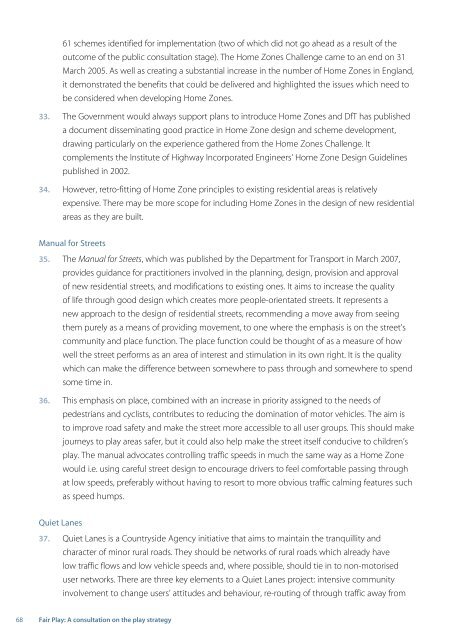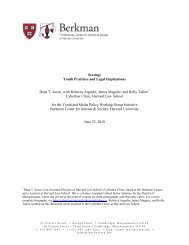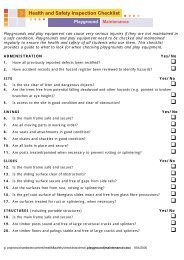Download PDF - Fair Play For Children
Download PDF - Fair Play For Children
Download PDF - Fair Play For Children
You also want an ePaper? Increase the reach of your titles
YUMPU automatically turns print PDFs into web optimized ePapers that Google loves.
61 schemes identified for implementation (two of which did not go ahead as a result of the<br />
outcome of the public consultation stage). The Home Zones Challenge came to an end on 31<br />
March 2005. As well as creating a substantial increase in the number of Home Zones in England,<br />
it demonstrated the benefits that could be delivered and highlighted the issues which need to<br />
be considered when developing Home Zones.<br />
33.<br />
34.<br />
The Government would always support plans to introduce Home Zones and DfT has published<br />
a document disseminating good practice in Home Zone design and scheme development,<br />
drawing particularly on the experience gathered from the Home Zones Challenge. It<br />
complements the Institute of Highway Incorporated Engineers’ Home Zone Design Guidelines<br />
published in 2002.<br />
However, retro-fitting of Home Zone principles to existing residential areas is relatively<br />
expensive. There may be more scope for including Home Zones in the design of new residential<br />
areas as they are built.<br />
Manual for Streets<br />
35. The Manual for Streets, which was published by the Department for Transport in March 2007,<br />
provides guidance for practitioners involved in the planning, design, provision and approval<br />
of new residential streets, and modifications to existing ones. It aims to increase the quality<br />
of life through good design which creates more people-orientated streets. It represents a<br />
new approach to the design of residential streets, recommending a move away from seeing<br />
them purely as a means of providing movement, to one where the emphasis is on the street’s<br />
community and place function. The place function could be thought of as a measure of how<br />
well the street performs as an area of interest and stimulation in its own right. It is the quality<br />
which can make the difference between somewhere to pass through and somewhere to spend<br />
some time in.<br />
36.<br />
This emphasis on place, combined with an increase in priority assigned to the needs of<br />
pedestrians and cyclists, contributes to reducing the domination of motor vehicles. The aim is<br />
to improve road safety and make the street more accessible to all user groups. This should make<br />
journeys to play areas safer, but it could also help make the street itself conducive to children’s<br />
play. The manual advocates controlling traffic speeds in much the same way as a Home Zone<br />
would i.e. using careful street design to encourage drivers to feel comfortable passing through<br />
at low speeds, preferably without having to resort to more obvious traffic calming features such<br />
as speed humps.<br />
Quiet Lanes<br />
37.<br />
Quiet Lanes is a Countryside Agency initiative that aims to maintain the tranquillity and<br />
character of minor rural roads. They should be networks of rural roads which already have<br />
low traffic flows and low vehicle speeds and, where possible, should tie in to non-motorised<br />
user networks. There are three key elements to a Quiet Lanes project: intensive community<br />
involvement to change users’ attitudes and behaviour, re-routing of through traffic away from<br />
68 <strong>Fair</strong> <strong>Play</strong>: A consultation on the play strategy





![The Childcare Act 2006 - Notes [Website] - Fair Play For Children](https://img.yumpu.com/50144819/1/184x260/the-childcare-act-2006-notes-website-fair-play-for-children.jpg?quality=85)




![Bouncy Castles [PDF] - Fair Play For Children](https://img.yumpu.com/45463572/1/184x260/bouncy-castles-pdf-fair-play-for-children.jpg?quality=85)






